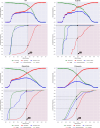Identifying Individuals at High Risk for HIV and Sexually Transmitted Infections With an Artificial Intelligence-Based Risk Assessment Tool
- PMID: 38440304
- PMCID: PMC10911222
- DOI: 10.1093/ofid/ofae011
Identifying Individuals at High Risk for HIV and Sexually Transmitted Infections With an Artificial Intelligence-Based Risk Assessment Tool
Abstract
Background: We have previously developed an artificial intelligence-based risk assessment tool to identify the individual risk of HIV and sexually transmitted infections (STIs) in a sexual health clinical setting. Based on this tool, this study aims to determine the optimal risk score thresholds to identify individuals at high risk for HIV/STIs.
Methods: Using 2008-2022 data from 216 252 HIV, 227 995 syphilis, 262 599 gonorrhea, and 320 355 chlamydia consultations at a sexual health center, we applied MySTIRisk machine learning models to estimate infection risk scores. Optimal cutoffs for determining high-risk individuals were determined using Youden's index.
Results: The HIV risk score cutoff for high risk was 0.56, with 86.0% sensitivity (95% CI, 82.9%-88.7%) and 65.6% specificity (95% CI, 65.4%-65.8%). Thirty-five percent of participants were classified as high risk, which accounted for 86% of HIV cases. The corresponding cutoffs were 0.49 for syphilis (sensitivity, 77.6%; 95% CI, 76.2%-78.9%; specificity, 78.1%; 95% CI, 77.9%-78.3%), 0.52 for gonorrhea (sensitivity, 78.3%; 95% CI, 77.6%-78.9%; specificity, 71.9%; 95% CI, 71.7%-72.0%), and 0.47 for chlamydia (sensitivity, 68.8%; 95% CI, 68.3%-69.4%; specificity, 63.7%; 95% CI, 63.5%-63.8%). High-risk groups identified using these thresholds accounted for 78% of syphilis, 78% of gonorrhea, and 69% of chlamydia cases. The odds of positivity were significantly higher in the high-risk group than otherwise across all infections: 11.4 (95% CI, 9.3-14.8) times for HIV, 12.3 (95% CI, 11.4-13.3) for syphilis, 9.2 (95% CI, 8.8-9.6) for gonorrhea, and 3.9 (95% CI, 3.8-4.0) for chlamydia.
Conclusions: Risk scores generated by the AI-based risk assessment tool MySTIRisk, together with Youden's index, are effective in determining high-risk subgroups for HIV/STIs. The thresholds can aid targeted HIV/STI screening and prevention.
Keywords: HIV; STIs; machine learning; risk assessment tool; sexually transmitted infections.
© The Author(s) 2024. Published by Oxford University Press on behalf of Infectious Diseases Society of America.
Conflict of interest statement
Potential conflicts of interest. All authors: no reported conflicts.
Figures
Similar articles
-
Web-Based Risk Prediction Tool for an Individual's Risk of HIV and Sexually Transmitted Infections Using Machine Learning Algorithms: Development and External Validation Study.J Med Internet Res. 2022 Aug 25;24(8):e37850. doi: 10.2196/37850. J Med Internet Res. 2022. PMID: 36006685 Free PMC article.
-
Low incidence of HIV infection and decreasing incidence of sexually transmitted infections among PrEP users in 2020 in Germany.Infection. 2023 Jun;51(3):665-678. doi: 10.1007/s15010-022-01919-3. Epub 2022 Sep 27. Infection. 2023. PMID: 36168098 Free PMC article.
-
Assessing disparity in the distribution of HIV and sexually transmitted infections in Australia: a retrospective cross-sectional study using Gini coefficients.BMJ Public Health. 2023 Aug 23;1(1):e000012. doi: 10.1136/bmjph-2023-000012. eCollection 2023 Nov. BMJ Public Health. 2023. PMID: 40017849 Free PMC article.
-
Diagnosis and Treatment of Sexually Transmitted Infections: A Review.JAMA. 2022 Jan 11;327(2):161-172. doi: 10.1001/jama.2021.23487. JAMA. 2022. PMID: 35015033 Review.
-
Risk of Human Immunodeficiency Virus Acquisition Among High-Risk Heterosexuals With Nonviral Sexually Transmitted Infections: A Systematic Review and Meta-Analysis.Sex Transm Dis. 2022 Jun 1;49(6):383-397. doi: 10.1097/OLQ.0000000000001601. Epub 2022 Jan 13. Sex Transm Dis. 2022. PMID: 35034049 Free PMC article.
Cited by
-
Radiomics analysis for the early diagnosis of common sexually transmitted infections and skin lesions.PLOS Digit Health. 2025 Jul 23;4(7):e0000926. doi: 10.1371/journal.pdig.0000926. eCollection 2025 Jul. PLOS Digit Health. 2025. PMID: 40700364 Free PMC article.
-
Artificial intelligence in assisting pathogenic microorganism diagnosis and treatment: a review of infectious skin diseases.Front Microbiol. 2024 Oct 8;15:1467113. doi: 10.3389/fmicb.2024.1467113. eCollection 2024. Front Microbiol. 2024. PMID: 39439939 Free PMC article. Review.
-
A Perspective on Home-Based Sexual Health Care: Evidence, Access, and Future Directions.Curr HIV/AIDS Rep. 2025 Feb 26;22(1):20. doi: 10.1007/s11904-025-00724-5. Curr HIV/AIDS Rep. 2025. PMID: 40000537 Free PMC article. Review.
-
What Do People Want from an AI-Assisted Screening App for Sexually Transmitted Infection-Related Anogenital Lesions: A Discrete Choice Experiment.Patient. 2025 Mar;18(2):131-143. doi: 10.1007/s40271-024-00720-8. Epub 2024 Nov 1. Patient. 2025. PMID: 39485672 Free PMC article.
-
User experiences of an AI application for predicting risk of sexually transmitted infections.Digit Health. 2024 Oct 18;10:20552076241289646. doi: 10.1177/20552076241289646. eCollection 2024 Jan-Dec. Digit Health. 2024. PMID: 39430696 Free PMC article.
References
-
- World Health Organization . Sexually transmitted infections (STIs) fact sheets. 2021. Available at: https://www.who.int/news-room/fact-sheets/detail/sexually-transmitted-in.... Accessed 20 August 2023.
-
- Fairley CK, Chow EP, Hocking JS. Early presentation of symptomatic individuals is critical in controlling sexually transmissible infections. Sex Health 2015; 12:181–2. - PubMed
-
- Power M, Dong K, Walsh J, Lewis DA, Richardson D. Barriers to HIV testing in hospital settings within a culturally diverse urban district of Sydney, Australia. Sex Health 2021; 18:340–3. - PubMed
-
- Blondell SJ, Debattista J, Griffin MP, Durham J. ‘I think they might just go to the doctor’: qualitatively examining the (un)acceptability of newer HIV testing approaches among Vietnamese-born migrants in greater-Brisbane, Queensland, Australia. Sex Health 2021; 18:50–7. - PubMed


